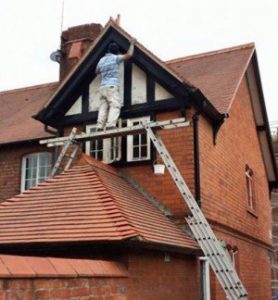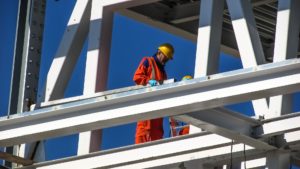Falls from height account for a significant proportion of workplace and at-home serious and fatal accidents in many countries around the world. In this article Andrew Sharman argues that we must to engage, encourage and empower workers to think differently about how they perceive risks in the workplace.
 We’ve all seen them haven’t we? The images in magazines and on the internet, those adrenalin-fuelled daredevils hell-bent on extreme sports. Each time we see them we catch our breath as we observe how they constantly push the limits whilst at the same time carefully seem to manage the ultra-fine balance between life and death. As we look on in wonder, are we witnessing a super-high degree of skill, learned through years of dedicated practice? As we look on in disbelief, though, we can’t help but wonder if they’re just lucky. Or plain stupid. What’s in their mind? Why do they do it?
We’ve all seen them haven’t we? The images in magazines and on the internet, those adrenalin-fuelled daredevils hell-bent on extreme sports. Each time we see them we catch our breath as we observe how they constantly push the limits whilst at the same time carefully seem to manage the ultra-fine balance between life and death. As we look on in wonder, are we witnessing a super-high degree of skill, learned through years of dedicated practice? As we look on in disbelief, though, we can’t help but wonder if they’re just lucky. Or plain stupid. What’s in their mind? Why do they do it?
Now, to set the record straight, I’m apt to partake in some pretty unusual hobbies. B.A.S.E. jumping, paragliding, sea kayaking, motorcycling and swimming with sharks would all feature in the ‘Hobbies & Interests’ section of my CV. But I’m not referring to these sorts of activities here – in fact, to be abundantly clear, I don’t even consider these ‘extreme’ sports, they are (at least to me) simply an activity with a degree of risk to be managed – just like football, rugby, martial arts, trail-running – and, arguably, even table tennis and almost any other sport you can think of. Rather, I’m referring to those idiots on ladders. The chap repairing the roof. The bloke installing the new satellite dish. Those two guys who realise they don’t have enough scaffolding and so create an alternative access using whatever comes to hand. The worker stretching out to joint a cable just out of reach. The engineer replacing a broken streetlamp. The painter leaning out to get that last little bit… These aerial acrobats have become so popular that there’s even now dedicated PowerPoint slideshows doing the rounds with photographs of such high-jinks, typically generating a guilty giggle and often incorporated into safety toolbox talks.
It doesn’t matter where we are in the world, we’re likely to find at least one ‘idiot on a ladder’ or working at height somewhere. Some of you, as health and safety practitioners or operational managers may have even found them in your own workplaces. Only last week during a site visit the factory manager I was with did a double-take as we turned a corner to find a forklift truck, engine running, driver in place, its forks raised to maximum height, with a ‘working platform’ made out of an old pallet, upon which stretched upwards the longest ladder I’d ever seen. Right at the top, many metres above us, was an intrepid maintenance technician – clearly no sufferer of vertigo – with wrench in hand, attempting to fix a leaking pipe. A few metres away, a pile of temporary scaffolding pipes and clips sat silently, just begging to be noticed.
Work at height has been a priority issue for most workplace safety regulators and inspectors around the world for many years. Without doubt, most readers of this journal would consider work at height as a potential ‘high risk’ task that requires careful assessment and planning, and diligence in execution. But why isn’t our assessment of these risks shared by the workers engaged in carrying out the task? And why is it that they seem so… oblivious to the very real and present danger that they place themselves in?
Falling from the stars (and stripes)
Falling from heights is one of the most common causes of admission to hospital in the United Kingdom, USA and several other supposedly ‘developed’ nations. Unsurprisingly it also ranks in the top ten of Accidental Deaths for many of these countries too. So why has our thinking not developed to such a degree to allow us to see the risks for what they are? But it’s not just the ordinary folks – in the last twelve months legendary tough guy Brad Pitt has taken a tumble leaving his handsome face scuffed and scarred, and Tom Cruise suffering a similar fate too.
And the winner is…
 Over in the UK there’s even a national tournament recognising the phenomenon. The ‘Idiots on Ladders’ competition recognises the stupidity of humankind when working at height. This year’s winner is a man way up on a building roof, charged with a repainting job. Acknowledging the challenge of building a scaffold to a hard-to-reach area, he creatively constructs his own using three ladders: one each side to act as the legs or brace, and a third positioned horizontally between them to create a platform on which he can balance and attempt to work.
Over in the UK there’s even a national tournament recognising the phenomenon. The ‘Idiots on Ladders’ competition recognises the stupidity of humankind when working at height. This year’s winner is a man way up on a building roof, charged with a repainting job. Acknowledging the challenge of building a scaffold to a hard-to-reach area, he creatively constructs his own using three ladders: one each side to act as the legs or brace, and a third positioned horizontally between them to create a platform on which he can balance and attempt to work.
It all sounds like a great jape but there is, of course, a serious side. For the last nine years the UK Ladder Association has used the ‘competition’ as a way to promote its annual Ladder Exchange campaign, where old ladders may be traded in towards new ones. The point of the campaign is clear – to reduce the number of damaged, broken or inadequate ladders in use and encourage people to think more about safe work at height. The association reports that over the years the campaign has facilitated the removal of several thousand unsafe ladders from service “thus reducing the risk of an accident resulting from a worn or faulty ladder.” But it’s not just about selling more new ladders: “Equally important is the fact that buyers and users of ladders, and the people who supervise their use, are encouraged to think about work at height safety in general.”
It’s this last idea that resonates with me. Think for a moment to the work at height activities in your workplace. I’ll wager that the majority of equipment being used is in good order, well-maintained, and often used in the correct manner for which it is designed. So why is it that work at height remains one of the leading causes of death and serious injury around the world? Is it simply because a fall from height typically has greater potentially to kill or maim? No, the real issue is around perception – risk perception to be exact. People simply don’t see the risks. Here’s four recent fatal accident cases to illustrate my point.
Case 1
A pregnant worker fell three metres through an open cellar hatch in a nightclub in the United Kingdom. The 23 year old woman was busy working behind the bar, turning to fetch more drinks for a customer she did not notice the hole in the floor behind her – the hatch had been left open by another worker who had descended into the cellar to retrieve stock – and promptly fell down the stairs to the cellar below. The opening of the cellar hatch behind the bar was common practice, especially in busy times where frequent stock replenishment was necessary. Indeed, the injured person had worked at the bar for several months and was familiar with the practice of opening the hatch having previously retrieved stock from the cellar herself, and even stepping over the open hatch to reach other parts of the bar area.
Case 2
In Lahore, Pakistan a worker died after falling from a crane during overhead works to create a new line on the metro network. The man had ventured out along the beam of the crane to replace a loose piece of pipe when he slipped and fell to his death. His aerial activities occurred just days after a site toolbox talk on the dangers of working at height which emphasised the need to ‘always clip-on’ with a harness.
Case 3
In Australia a worker died whilst operating a scissor lift during construction of the new Royal Adelaide Hospital. The worker sustained fatal injuries when he was crushed between the lift and a concrete slab overhead. The deceased was the only operator of the controls of the scissor lift, and it was he who raised the platform towards the ceiling. The incident was strikingly similar to a previous accident in November 2014 on the same site.
Case 4
A worker on Shell’s Brent Charlie oil platform plunged 23 metres into the North Sea when a sharp edge severed his access rope. The worker had descended on abseil equipment through an access hatch to retrieve fallen items and debris from below the main deck. Upon completing the task, the worker began to climb back up, however his weight pulled the rope tight against the sharp edge of the access hatch, severing it and allowing him to fall to his death.
In each of these four cases, even on the limited information I provide you with, I’m certain that you’re already spotting the risks and picking up on crucial points for action. So it would appear, at least on face value, that each worker just didn’t see the risks in the way we might expect them to.
Assessing the risks
The accidents above highlight two key issues. The first is around assessment of the actual risks – subsequent investigations in each case found that the formal risk assessments were, at best, lacking. In two of the events, risk assessments were not even completed.
For example, in its investigation of the oil platform death, the Health & Safety Executive found that the task had not been properly planned: “Assessing the risks of the job properly would have identified that the potentially sharp edge presented a very clear danger to anyone suspended and working on ropes rigged against it.” But it transpired that the risk assessment had failed to include the risk of ropes being cut or damaged by such sharp edges and instead simply referred to “generic (work at height) procedures… rather than being really focused on the job in hand.”
I’m confident that readers will be savvy with the art of robust risk assessment and don’t intend to use page space here to harp on about the importance of this, or clipping on, cordoning off areas below, or the use of hard hats above and below. Instead let’s focus on digging deeper. The second key issue is perhaps the more challenging: risk perception. So, let’s return to the oil platform. During the set up of the job, the deceased and his team members were aware that the access ropes needed to run over the edge of the hatch, however they did not spot the very real risk of the rope being severed by the hatch edge, instead they “just saw a rather dirty piece of steelwork and didn’t recognise it as being sharp.”
Golden rules
 Work at height often features in an organisation’s Golden Rules for workplace health and safety. The logic behind Golden Rules is sensible: identify the biggest risks of fatal or serious injuries and create an absolute non-negotiable rule for their control. Just like on the Pakistan construction site in the case study above, many of our clients have in the past typically include a statement such as “All work at height must be properly controlled. Those working at height must always wear a harness and be clipped on at all times.” But that doesn’t mean that it always happens like that, does it? Could it be that the workers’ perception of the risk doesn’t match the intent of the rule?
Work at height often features in an organisation’s Golden Rules for workplace health and safety. The logic behind Golden Rules is sensible: identify the biggest risks of fatal or serious injuries and create an absolute non-negotiable rule for their control. Just like on the Pakistan construction site in the case study above, many of our clients have in the past typically include a statement such as “All work at height must be properly controlled. Those working at height must always wear a harness and be clipped on at all times.” But that doesn’t mean that it always happens like that, does it? Could it be that the workers’ perception of the risk doesn’t match the intent of the rule?
Just a few weeks ago I’d been through a pretty robust site safety induction before being taken for a tour around a large construction site in downtown Johannesburg. This creation of a new global headquarters was indeed awe-inspiring, with ten floors above ground and three more below, the building was magnificent in both terms of size and its architectural splendour. The site’s Golden Rules were fresh in my mind. Rule number four concerned work at height: “Work at Height means any work performed more than 1.2 metres above the ground. Harnesses and lanyards must be inspected before each use. Workers must always clip on to a secure point when working at height.” Straight-forward and clear, I thought. Venturing out onto the site I stood in what would become the main reception area, a vast space which would become replete with a massive vaulted glass-ceiling. From here I felt like a tiny ant as I looked up at the galleries of each floor above me. Climbing the scaffolding staircase we ascended towards the roof. On the fifth floor however, we had cause to break. Two men, kneeling on the floor, were working to install fixings for the gallery windows. Both were wearing harnesses, neither were clipped on. When asked about the Golden Rule for working at height their response was spot on: “You must clip on if you are more than 1.2 metres up.” But I was surprised when he added “We are sitting on the ground though, not on a scaffolding or ladder, so it doesn’t apply here to us.” Even when my guide nodded towards the drop of five floors just a few feet from where the man sat, he was still puzzled. His understanding was that he must have actually climbed up something first to make the rule come into play. Although he knew he was on the fifth floor of a skeleton-like work-in-progress construction, and had been up and down on all levels every day for several weeks, he simply couldn’t see the very real and very serious risk of falling from height right in front of him. To this man, all was normal. He spent his day installing window brackets, usually whilst sitting or kneeling on the ground. Sometimes on level one, sometimes level three, four, five, ten. He had become so familiar with the heights that he didn’t see the risk, nor the applicability of the rule.
The absence of accidents does not equal the existence of safety
Further discussions with our man revealed that he had never suffered a fall from height in his career; he’d “always been careful” he added. This notion that a wealth of experience makes us invincible to risk is reinforced in some people because “it’s never happened to me”. But as I’ve suggested in previous articles and also in my book From Accidents to Zero, the absence of accidents does not equal the existence of safety. In fact, ask anyone who has survived a fall from height and almost all will say that they didn’t see it coming. Some, like Jason Anker[1] will even go out of their way to share their story in the hope that it prevents someone else suffering the same fate.
So what can we do about risk perception? Whether it’s working at height, or any other potentially risky work task, maybe an alternate angle could help. All too frequently risk assessments are completed at the desk-top. In the event that the assessor gets out to the work location, the activity is often done in relative silence, perhaps ignoring the workers themselves. In our bid to create safety in the workplace employee engagement is vital. It’s time to build dialogue rather than assume alignment on risk. Try asking workers “What is slow, inconvenient or uncomfortable about doing this job safely?” – it’s a sure-fire winner to get them thinking. You’ll either get suggestions for improvement, or confirmation that things are under control. With the latter you then have room for a follow-up: “So, if I were working with you today, what would I need to know in order to go home safely after work?” More thinking encouraged, and a verbal confirmation of the risks, rules and procedures associated with the job which serves well as salient reminder to the worker. If you spot a risk that’s not been mentioned this can be dropped into the conversation at this point and discussion continued. You might even try “So what could we do to make this task even safer?” Safety dialogues like this can be done at any time, not just during the risk assessment process, and by anyone, not just the safety manager. They can even be used by managers and supervisors on a daily basis to boost risk awareness right around the workplace.
The time for toolbox talks showing idiots on ladders has passed, let’s move beyond ‘superheroes on stilts’ and use good old-fashioned conversation to engage, empower and equip our workers with enhanced risk perception skills. It might just stop them – and you – from falling from grace.
About the author
Professor Andrew Sharman is a consultant to top leaders at Apple, Burberry, IKEA, Heineken, MercedesBenz and more, and the co-creator of the world’s only IOSH certificate in Behavioural Safety Leadership, find out more at: https://www.behaviouralsafetyservices.com/courses/iosh-accredited-behavioural-safety-course-elearning/ Oh hey, email [email protected] and quote SHP25 to get 25% off your course.
In From Accidents to Zero – the world’s best-selling book on safety culture – Sharman shares more than 80 ideas that help leaders drive strategic safety improvement, improve culture and enable excellence. Get your copy of the book with an exclusive 25% discount by using the code SHP25 at www.fromaccidentstozero.com to order your copy now.
[1] Jason Anker fell from a ladder when in his early twenties. He’s spent the rest of his life paralysed from the waist down. Awarded an MBE from Her Majesty the Queen Elizabeth II, Jason tirelessly travels the world – in his wheelchair – to re-tell the heart-touching story of that fateful day and how it has affected his life ever since. Find out more at www.proud2Bsafe.co.uk
Why should you subscribe to the SHP newsletter?
Do you want the very latest health and safety news, product launches, job listings and expert opinions sent straight to your inbox daily?
The SHP newsletter is essential reading – sign up today to get your hands on all this!

 We’ve all seen them haven’t we? The images in magazines and on the internet, those adrenalin-fuelled daredevils hell-bent on extreme sports. Each time we see them we catch our breath as we observe how they constantly push the limits whilst at the same time carefully seem to manage the ultra-fine balance between life and death. As we look on in wonder, are we witnessing a super-high degree of skill, learned through years of dedicated practice? As we look on in disbelief, though, we can’t help but wonder if they’re just lucky. Or plain stupid. What’s in their mind? Why do they do it?
We’ve all seen them haven’t we? The images in magazines and on the internet, those adrenalin-fuelled daredevils hell-bent on extreme sports. Each time we see them we catch our breath as we observe how they constantly push the limits whilst at the same time carefully seem to manage the ultra-fine balance between life and death. As we look on in wonder, are we witnessing a super-high degree of skill, learned through years of dedicated practice? As we look on in disbelief, though, we can’t help but wonder if they’re just lucky. Or plain stupid. What’s in their mind? Why do they do it? Over in the UK there’s even a national tournament recognising the phenomenon. The ‘Idiots on Ladders’ competition recognises the stupidity of humankind when working at height. This year’s winner is a man way up on a building roof, charged with a repainting job. Acknowledging the challenge of building a scaffold to a hard-to-reach area, he creatively constructs his own using three ladders: one each side to act as the legs or brace, and a third positioned horizontally between them to create a platform on which he can balance and attempt to work.
Over in the UK there’s even a national tournament recognising the phenomenon. The ‘Idiots on Ladders’ competition recognises the stupidity of humankind when working at height. This year’s winner is a man way up on a building roof, charged with a repainting job. Acknowledging the challenge of building a scaffold to a hard-to-reach area, he creatively constructs his own using three ladders: one each side to act as the legs or brace, and a third positioned horizontally between them to create a platform on which he can balance and attempt to work. Work at height often features in an organisation’s Golden Rules for workplace health and safety. The logic behind Golden Rules is sensible: identify the biggest risks of fatal or serious injuries and create an absolute non-negotiable rule for their control. Just like on the Pakistan construction site in the case study above, many of our clients have in the past typically include a statement such as “All work at height must be properly controlled. Those working at height must always wear a harness and be clipped on at all times.” But that doesn’t mean that it always happens like that, does it? Could it be that the workers’ perception of the risk doesn’t match the intent of the rule?
Work at height often features in an organisation’s Golden Rules for workplace health and safety. The logic behind Golden Rules is sensible: identify the biggest risks of fatal or serious injuries and create an absolute non-negotiable rule for their control. Just like on the Pakistan construction site in the case study above, many of our clients have in the past typically include a statement such as “All work at height must be properly controlled. Those working at height must always wear a harness and be clipped on at all times.” But that doesn’t mean that it always happens like that, does it? Could it be that the workers’ perception of the risk doesn’t match the intent of the rule?